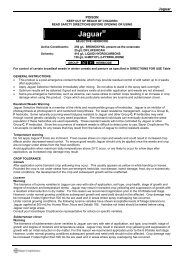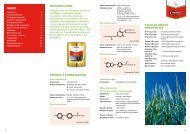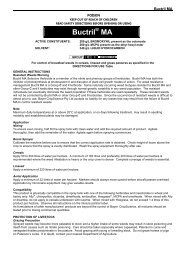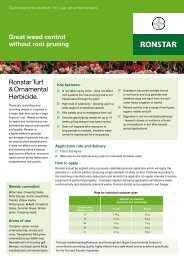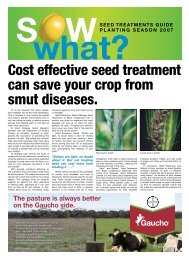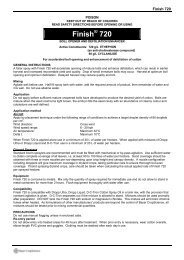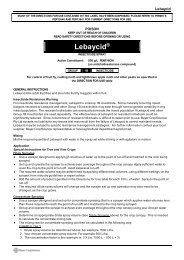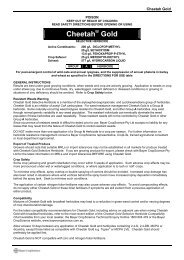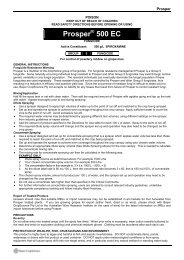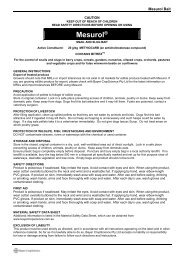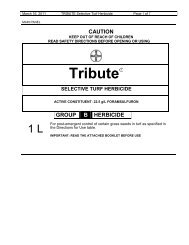Bayer Chlorothalonil 500 SC - Bayer CropScience
Bayer Chlorothalonil 500 SC - Bayer CropScience
Bayer Chlorothalonil 500 SC - Bayer CropScience
Create successful ePaper yourself
Turn your PDF publications into a flip-book with our unique Google optimized e-Paper software.
POISON<br />
KEEP OUT OF REACH OF CHILDREN<br />
READ SAFETY DIRECTIONS BEFORE OPENING OR USING<br />
<strong>Bayer</strong> <strong>Chlorothalonil</strong> <strong>500</strong> <strong>SC</strong><br />
FUNGICIDE<br />
Active Constituent: <strong>500</strong> g/L CHLOROTHALONIL<br />
GROUP Y FUNGICIDE<br />
<strong>Bayer</strong> <strong>Chlorothalonil</strong> <strong>500</strong> <strong>SC</strong><br />
For the control of a wide variety of fungal diseases in various situations as specified in the DIRECTIONS FOR<br />
USE table<br />
GENERAL INSTRUCTIONS<br />
For effective disease control a good leaf cover must be achieved before a widespread disease outbreak occurs.<br />
Fungicide Resistance Warning<br />
For fungicide resistance management <strong>Bayer</strong> <strong>Chlorothalonil</strong> <strong>500</strong> <strong>SC</strong> is a group Y fungicide. Some naturally occurring<br />
individual fungi resistant to the product and other Group Y fungicides may exist through normal genetic variability in any<br />
fungal population. The resistant individuals can eventually dominate the fungal population if these fungicides are used<br />
repeatedly. These resistant fungi will not be controlled by this product or other Group Y fungicides, thus resulting in a<br />
reduction in efficacy and possible yield loss. Since the occurrence of resistant fungi is difficult to detect prior to use,<br />
<strong>Bayer</strong> <strong>CropScience</strong> Pty Ltd accepts no liability for any losses that result from the failure of this product to control resistant<br />
fungi.<br />
Export of treated produce<br />
Growers should note that MRLs or import tolerances do not exist in all markets for edible produce treated with <strong>Bayer</strong><br />
<strong>Chlorothalonil</strong>. If you are growing edible produce for export, please check with <strong>Bayer</strong> <strong>CropScience</strong> Pty Ltd for the latest<br />
information on MRLs and import tolerances before using <strong>Bayer</strong> <strong>Chlorothalonil</strong>.<br />
Mixing/Application<br />
Thoroughly shake and roll the pack several times before opening. Mix the required quantity of <strong>Bayer</strong> <strong>Chlorothalonil</strong> <strong>500</strong><br />
<strong>SC</strong> with water in the spray vat while stirring or with agitators in motion.<br />
Suggested spray volumes – non tree/vine crops<br />
Low volume: 200 or more litres per hectare.<br />
High volume: <strong>500</strong> -1000 litres per hectare.<br />
Aerial application: 20 litres or more per hectare.<br />
Mister: 75-255 litres per hectare.<br />
The volume of water applied should increase as the plants grow in size to maintain adequate cover.<br />
Special Instruction for Tree/Vine crops<br />
Dilute Spraying<br />
♦ Use a sprayer designed to apply high volumes of water up to the point of run-off and matched to the crop being<br />
sprayed.<br />
♦ Set up and operate the sprayer to achieve even coverage throughout the crop canopy. Apply sufficient water to<br />
cover the crop to the point of run-off. Avoid excessive run-off.<br />
♦ The required water volume may be determined by applying different test volumes, using different settings on the<br />
sprayer, from industry guidelines or expert advice.<br />
♦ Add the amount of product specified in the Directions for Use table for each 100 L of water. Spray to the point of<br />
run-off.<br />
♦ The required dilute spray volume will change and the sprayer set up and operation may also need to be changed, as<br />
the crop grows.<br />
Concentrate Spraying<br />
♦ Use a sprayer designed and set up for concentrate spraying (that is a sprayer which applies water volumes less<br />
than those required to reach the point of run-off) and matched to the crop being sprayed.<br />
♦ Set up and operate the sprayer to achieve even coverage throughout the crop canopy using your chosen water<br />
volume.<br />
♦ Determine an appropriate dilute spray volume (See Dilute Spraying above) for the crop canopy. This is needed to<br />
calculate the concentrate mixing rate.<br />
♦ The mixing rate for concentrate spraying can then be calculated in the following way:
<strong>Bayer</strong> <strong>Chlorothalonil</strong> <strong>500</strong> <strong>SC</strong><br />
EXAMPLE ONLY<br />
1. Dilute spray volume as determined above: For example 1000 L/ha<br />
2. Your chosen concentrate spray volume: For example 250 L/ha<br />
3. The concentration factor in this example is: 4 X (i.e. 1000 L ÷ 250 L = 4)<br />
4. If the dilute label rate is 230 mL/100 L, then the concentrate rate becomes 4 x 230, that is 920 mL/100 L<br />
of concentrate spray.<br />
♦ The chosen spray volume, amount of product per 100 L of water, and the sprayer set up and operation may need to<br />
be changed as the crop grows.<br />
♦ For concentrate spraying, do not use greater than a 5X concentration factor.<br />
For further information on concentrate spraying, users are advised to consult relevant industry guidelines, undertake<br />
appropriate competency training and follow industry Best Practices.<br />
Compatibility<br />
<strong>Bayer</strong> <strong>Chlorothalonil</strong> <strong>500</strong> <strong>SC</strong> is compatible with wettable powder and flowable formulations of most commonly used<br />
fungicides, insecticides and miticides. Unless experience in your area has shown other combinations to be physically<br />
compatible and non-injurious to your crop DO NOT combine with other chemicals, especially emulsifiable concentrates.<br />
Do not mix concentrates together but add each to the spray tank separately. As formulations of other manufacturers'<br />
products are beyond the control of <strong>Bayer</strong> <strong>CropScience</strong> Pty Ltd, all mixtures should be tested prior to mixing commercial<br />
quantities. As changes in climatic conditions can alter the sensitivity of plants to mixtures of sprays, <strong>Bayer</strong> <strong>CropScience</strong><br />
cannot be responsible for the behaviour of such mixtures.<br />
DO NOT mix spraying oils, wetting agents or surfactants with this product. The addition of these does not improve this<br />
product's effectiveness and under some conditions may cause plant injury.<br />
PROTECTION OF WILDLIFE, FISH, CRUSTACEANS AND ENVIRONMENT<br />
This product is harmful to fish. DO NOT contaminate ponds, dams, waterways or ditches with product or used container.<br />
DO NOT reuse the container for any other purpose.<br />
DRIFT WARNING<br />
DO NOT apply under weather conditions, or from spraying equipment, which could be expected to cause spray to drift<br />
onto adjacent crops, crop lands, pastures or livestock.<br />
STORAGE AND DISPOSAL<br />
Store in the closed, original container in a cool, well-ventilated area. Do not store for prolonged periods in direct sunlight.<br />
Triple or preferably pressure rinse containers before disposal. Add rinsings to spray tank. Do not dispose of undiluted<br />
chemicals on site. If recycling, replace cap and return clean containers to recycler or designated collection point. If not<br />
recycling, break, crush, or puncture and bury empty containers in a local authority landfill. If no landfill is available, bury<br />
the containers below <strong>500</strong> mm in a disposal pit specifically marked and set up for this purpose clear of waterways,<br />
desirable vegetation and tree roots. Empty containers and product should not be burnt.<br />
SAFETY DIRECTIONS<br />
Attacks eyes and skin. Avoid contact with eyes and skin. Do not inhale spray mist. Repeated exposure may cause<br />
allergic disorders. Sensitive workers should use protective clothing. When preparing spray and using the prepared<br />
spray wear cotton overalls buttoned to the neck and wrist, washable hat, elbow-length PVC gloves, goggles and<br />
disposable face mask. If clothing becomes contaminated with product or wet with spray remove clothing immediately. If<br />
product on skin, immediately wash area with soap and water. If product in eyes, wash it out immediately with water.<br />
After use and before eating, drinking or smoking, wash hands, arms and face thoroughly with soap and water. After each<br />
day's use, wash gloves, goggles and contaminated clothing.<br />
FIRST AID<br />
If poisoning occurs contact a doctor or Poisons Information Centre (telephone 13 11 26). If swallowed, do NOT induce vomiting.<br />
Give a glass of water.<br />
MATERIAL SAFETY DATA SHEET<br />
Additional information is listed in the Material Safety Data Sheet, which can be obtained from www.bayercropscience.com.au.<br />
EXCLUSION OF LIABILITY<br />
This product must be used strictly as directed, and in accordance with all instructions appearing on the label and in other<br />
reference material. So far as it is lawfully able to do so, <strong>Bayer</strong> <strong>CropScience</strong> Pty Ltd accepts no liability or responsibility<br />
for loss or damage arising from failure to follow such directions and instructions.<br />
APVMA Approval No. 4<strong>500</strong>8/1004 FOR 24 HOUR SPECIALIST ADVICE<br />
IN EMERGENCY ONLY<br />
PHONE 1800 033 111
<strong>Bayer</strong> <strong>Chlorothalonil</strong> <strong>500</strong> <strong>SC</strong><br />
DIRECTIONS FOR USE<br />
Restraints<br />
DO NOT mix spraying oils, wetting agents or surfactants with this product.<br />
For all stone fruit except cherries, the following additional restraints apply:<br />
Do not use oils after bud-swell and during the season if <strong>Bayer</strong> <strong>Chlorothalonil</strong> is to be used after shuck fall.<br />
Do not tank mix <strong>Bayer</strong> <strong>Chlorothalonil</strong> with EC formulations when spraying after shuck fall.<br />
Do not exceed 4.6 L of <strong>Bayer</strong> <strong>Chlorothalonil</strong> <strong>500</strong> <strong>SC</strong> per hectare of crop.<br />
TREE AND VINE CROPS<br />
RATE<br />
In the following table, all rates given are for dilute spraying. For<br />
concentrate spraying, refer to the Mixing/Application section.<br />
CROP DISEASE RATE WHP<br />
(days)<br />
Almonds<br />
(NOT Qld or<br />
NT)<br />
Apricots<br />
(NOT Qld or<br />
NT)<br />
Cherries<br />
Grapes<br />
(Note -<br />
russeting of<br />
some table<br />
grape<br />
varieties may<br />
Shot hole,<br />
stone fruit rust<br />
Blossom blight,<br />
brown rot - fruit<br />
Freckle,<br />
shot-hole,<br />
stone fruit rust<br />
Transit rot<br />
Blossom blight,<br />
brown rot – fruit<br />
Shot-hole,<br />
stone fruit rust<br />
Transit rot<br />
(Rhizopus stolonifer)<br />
Bunch rot,<br />
downy mildew<br />
230 mL/100 L<br />
230 mL/100 L<br />
230 - 300<br />
mL/100 L<br />
occur) Black spot 300 mL/100 L<br />
Nectarines<br />
Shot-hole<br />
(NSW, ACT, Vic,<br />
Tas, SA, WA ONLY)<br />
Blossom blight,<br />
brown rot - fruit<br />
(NSW, ACT, Tas,<br />
WA ONLY)<br />
CRITICAL COMMENTS<br />
For all uses in this table: Apply by dilute or concentrate<br />
spraying equipment. Apply the same total amount of<br />
product to the target crop whether applying this product by<br />
dilute or concentrate spraying methods. For concentrate<br />
spraying, DO NOT use greater than a 5X concentration<br />
factor.<br />
- Apply at bud-swell, bud-burst, shuck fall, cap fall. Apply<br />
every 10-14 days. Apply 1 week pre-harvest.<br />
7<br />
Dessert<br />
7<br />
Wine<br />
14<br />
230 mL/100 L 7<br />
Apply at bud-swell, bud-burst, pink bud, full bloom. Apply<br />
no later than 35 days pre-harvest. See also Additional<br />
Restraints for stone fruits.<br />
Apply at bud-swell, bud-burst, pink bud, shuck fall, cap fall,<br />
then every 10-14 days. Apply no later than 35 days preharvest.<br />
See also Additional Restraints for stone fruits.<br />
Apply 7 days pre-harvest. See also Additional Restraints<br />
for stone fruits.<br />
Apply at bud-swell, bud-burst, pink bud, early blossom, full<br />
bloom. Apply 3 weeks pre-harvest and 1 week pre-harvest.<br />
Apply at bud-swell, bud-burst, pink bud, shuck fall, cap fall,<br />
then apply every 10-14 days. Apply 1 week pre-harvest.<br />
Apply 1 week pre-harvest.<br />
Spray at first appearance of the foliage disease. Apply at<br />
7-14 day intervals particularly during wet weather and<br />
periods of rapid growth. For bunch rot, applications at early<br />
full bloom, two weeks later, at veraisson and two weeks<br />
prior to harvest. Table grapes - russeting of some varieties<br />
may occur. Use only up to cap fall on these varieties.<br />
If black spot has occurred in the vineyard in any of the last<br />
three years, apply at budburst and 14 days later when<br />
shoots are 10-15 cm long.<br />
If wet/humid conditions persist spray again when shoots<br />
are 20-30 cm long to protect new growth. Some initial<br />
minimal leaf damage on the new shoots of sensitive<br />
varieties can occur if spray treatments are applied at<br />
budburst and in the first 14 days after budburst. In<br />
vineyards with no history of black spot, spray only at the<br />
first appearance of the disease on foliage and then 7-14<br />
day intervals if wet/humid conditions persist. Applications<br />
up to cap-fall will not cause russeting in table grape and<br />
dried fruit varieties.<br />
Apply at bud-swell, pink bud, shuck fall and then repeat<br />
each 14 days if weather conditions favour disease. Apply<br />
no later than 35 days pre-harvest. See also Additional<br />
Restraints for stone fruits.<br />
Apply at bud-swell, bud-burst, pink bud, early blossom and<br />
full bloom. Apply no later than 35 days pre-harvest. See<br />
also Additional Restraints for stone fruits.
TREE AND VINE CROPS (continued)<br />
RATE<br />
In the following table, all rates given are for dilute spraying. For<br />
concentrate spraying, refer to the Mixing/Application section.<br />
CROP DISEASE RATE WHP<br />
(days)<br />
Peaches<br />
Plums<br />
Blossom blight,<br />
brown rot - fruit<br />
Shot-hole,<br />
stone fruit rust<br />
Leaf curl<br />
Blossom blight,<br />
brown rot - fruit<br />
Shot-hole,<br />
stone fruit rust<br />
230 mL/100 L 7<br />
230 mL/100 L 1<br />
NON TREE AND VINE CROPS<br />
CROP DISEASE RATE WHP<br />
(days)<br />
Artichokes -<br />
globe<br />
(Qld, WA<br />
ONLY)<br />
Bananas<br />
(DO NOT apply<br />
to bananas<br />
within 14 days<br />
of applying an<br />
oil based spray<br />
or crop<br />
damage will<br />
occur)<br />
Beans - broad<br />
(faba)<br />
(Tas, WA<br />
ONLY)<br />
Broccoli,<br />
Brussels<br />
sprouts,<br />
cabbages,<br />
cauliflowers<br />
Capsicums,<br />
peppers<br />
(Qld, WA<br />
ONLY)<br />
<strong>Bayer</strong> <strong>Chlorothalonil</strong> <strong>500</strong> <strong>SC</strong><br />
CRITICAL COMMENTS<br />
For all uses in this table: Apply by dilute or concentrate<br />
spraying equipment. Apply the same total amount of<br />
product to the target crop whether applying this product by<br />
dilute or concentrate spraying methods. For concentrate<br />
spraying, DO NOT use greater than a 5X concentration<br />
factor.<br />
Apply at bud-swell, pink bud, early blossom and full bloom.<br />
Apply no later than 35 days pre-harvest. See also<br />
Additional Restraints for stone fruits.<br />
Apply at bud-swell and continue at 7-14 day intervals.<br />
Apply no later than 35 days pre-harvest. See also<br />
Additional Restraints for stone fruits.<br />
Apply at bud-swell and continue at 7-14 day intervals. In<br />
Qld spray only at bud-swell. Apply no later than 35 days<br />
pre-harvest. See also Additional Restraints for stone fruits.<br />
Apply at bud-swell, bud-burst, early blossom, pink bud and<br />
full bloom. Apply no later than 35 days pre-harvest. See<br />
also Additional Restraints for stone fruits.<br />
Apply at bud-swell, bud-burst, shuck fall and cap fall. Apply<br />
no later than 35 days pre-harvest. See also Additional<br />
Restraints for stone fruit.<br />
CRITICAL COMMENTS<br />
Grey mould 2.6 - 3.3 L/ha 1 Apply at 7-10 day intervals. Use higher rate if disease<br />
pressure is high.<br />
Leaf spot<br />
Leaf speckle<br />
(Qld, NSW, WA, NT<br />
ONLY)<br />
Chocolate spot,<br />
rust<br />
Ring spot<br />
Anthracnose<br />
(Colletotrichum<br />
acutatum),<br />
grey mould<br />
(Botrytis cinerea)<br />
Carrots Leaf blight<br />
(Alternaria dauci)<br />
Celery<br />
Late blight<br />
Septoria leaf spot<br />
(Septoria apiicola)<br />
Cercospora early<br />
blight<br />
(Cercospora apii)<br />
(NSW, ACT, WA<br />
ONLY)<br />
2.6 L/ha<br />
(Qld, NSW<br />
ONLY)<br />
2.2 L/ha<br />
(WA ONLY)<br />
4.3 L/ha<br />
1<br />
For North Qld: Spray every 14 days late January to end<br />
of March. Extend to 21 days after March and then 28-35<br />
days in the drier months of the year.<br />
For South Qld: Spray every 21 days from start of<br />
December to end of April.<br />
For WA: Spray every 10-14 days from November to end<br />
of May and extend to 14-21 days from May to November.<br />
For NSW: Spray every 21 days from end of November to<br />
end of May.<br />
Spray schedule same as for control of leaf spot. <strong>Bayer</strong><br />
<strong>Chlorothalonil</strong> <strong>500</strong> <strong>SC</strong> will not eradicate infection already<br />
present but will prevent the spread of disease.<br />
2 - 3.3 L/ha 7 Apply at first sign of disease on the leaves or if weather<br />
conditions indicate likely incidence of disease. Repeat at<br />
7-14 day intervals. Use the higher rate if the crop is<br />
dense and disease pressure is high.<br />
2.5 - 5 L/ha 7 Apply at first sign of disease on the leaves or if weather<br />
conditions indicate likely incidence of disease. Repeat at<br />
14 day intervals. Use higher rate if disease pressure is<br />
high.<br />
2.6 - 3.3 L/ha 1 Apply at 7-10 day intervals as required. Use the higher<br />
rate if disease pressure is high.<br />
2.6 L/ha<br />
or<br />
230 mL/100 L<br />
2.6 L/ ha<br />
or<br />
230 mL/100 L<br />
1.8 L/ha<br />
7 Commence application at first sign of disease and then<br />
spray every 7-14 days.<br />
1<br />
Apply every 7-14 days. Apply also to seed beds.<br />
Apply every 10-14 days.
NON TREE AND VINE CROPS (continued)<br />
CROP DISEASE RATE WHP<br />
(days)<br />
Cucurbits<br />
(including<br />
cantaloupe,<br />
cucumber,<br />
honeydew,<br />
muskmelon,<br />
pumpkin,<br />
squash,<br />
rockmelon,<br />
watermelon,<br />
zucchini)<br />
Endive<br />
(Qld, WA ONLY)<br />
Leeks,<br />
shallots<br />
(Qld, WA ONLY)<br />
Okra<br />
(Qld, WA ONLY)<br />
Onions<br />
(excluding spring<br />
onions)<br />
Ornamentals,<br />
chrysanthemums,<br />
geraniums,<br />
iris and other<br />
ornamentals<br />
(Tas, WA ONLY)<br />
Peanuts<br />
(Qld, NSW, WA,<br />
NT ONLY)<br />
Peas<br />
(Tas, WA ONLY)<br />
Potato<br />
Radish<br />
(Qld, WA ONLY)<br />
Rhubarb<br />
(NSW, ACT, WA<br />
ONLY)<br />
Sweet corn<br />
(Qld, WA ONLY)<br />
Tobacco<br />
(Qld, WA ONLY)<br />
Anthracnose,<br />
downy mildew,<br />
gummy stem blight,<br />
leaf blight<br />
(Alternaria<br />
cucumerina),<br />
target leaf spot<br />
(Cercospora<br />
citrullina)<br />
Belly rot<br />
Grey mould<br />
Purple blotch<br />
(Alternaria porri)<br />
2.4 - 3.6 L/ha 1<br />
CRITICAL COMMENTS<br />
<strong>Bayer</strong> <strong>Chlorothalonil</strong> <strong>500</strong> <strong>SC</strong><br />
Apply on a 7-14 day schedule. Apply rates towards the<br />
higher end of the recommended range at 7 day intervals<br />
when disease pressure is high. Commence spray<br />
program early, at first true leaf and before vining or<br />
flowering.<br />
When used at these rates, <strong>Bayer</strong> <strong>Chlorothalonil</strong> <strong>500</strong> <strong>SC</strong><br />
will suppress powdery mildew.<br />
2.6 - 3.3 L/ha 1<br />
If applying <strong>Bayer</strong> <strong>Chlorothalonil</strong> <strong>500</strong> <strong>SC</strong> for the above<br />
foliar diseases suppression of belly rot will be obtained<br />
where fruit form on soil covered by earlier recent <strong>Bayer</strong><br />
<strong>Chlorothalonil</strong> <strong>500</strong> <strong>SC</strong> spraying.<br />
Apply at 7-10 day intervals as required. Use higher rate<br />
if disease pressure is high.<br />
2.6 - 3.3 L/ha 1 Apply at first appearance of disease. Repeat at 7-10<br />
day intervals, particularly during wet weather.<br />
Leaf disease/spot 2.6 - 3.3 L/ha 1 Apply at first appearance of disease. Repeat at 7 to 10<br />
day intervals.<br />
Downy mildew 3.3 L/ha 14 Apply at first sign of disease on the leaves or if weather<br />
conditions indicate likely incidence of disease. Repeat<br />
at 14 day intervals.<br />
Alternaria leaf spot 150 mL/100 L - Apply at 7-14 day intervals. Use 7 days under severe<br />
diseases,<br />
conditions. Avoid application to blooms in azalea,<br />
Botrytis,<br />
grey mould,<br />
rust diseases,<br />
Septoria<br />
hydrangea and petunia.<br />
Early leaf spot, 1.6 - 2.6 L/ha - Use higher rate when conditions favour leaf spot or<br />
late leaf spot,<br />
or<br />
when rust appears. DO NOT feed peanut vines to<br />
net blotch,<br />
140 - 230 mL/<br />
livestock.<br />
peanut rust,<br />
100 L<br />
NSW AND WA ONLY:<br />
peppery leaf spot<br />
Commence application when disease first appears and<br />
(Leptosphaerulina<br />
repeat as necessary to maintain control.<br />
trifolii)<br />
Qld ONLY:<br />
NORTH AND SOUTH BURNETT: Commence spraying<br />
when disease appears and repeat when rain and warm<br />
moist nights are expected.<br />
ATHERTON TABLELANDS: Commence spraying 4-6<br />
weeks after planting and repeat at 7-14 day intervals<br />
depending on conditions.<br />
Downy mildew 1.6 - 2.6 L/ha 7 Apply at first sign of disease on the leaves or if weather<br />
conditions indicate likely incidence of disease. Repeat<br />
at 7-14 day intervals. Use the higher rate if the crop is<br />
dense and disease pressure is high.<br />
Early blight or target 1.6 - 2.6 L/ha - Spray at first sign of foliage disease or at flowering time,<br />
spot<br />
whichever is earlier. Spray every 7-14 days until within<br />
Late blight or Irish<br />
blight<br />
14 days of desiccation or harvest.<br />
Grey mould<br />
2.6 - 3.3 L/ha 1 Apply at 7-10 day intervals as required. Use higher rate<br />
(Botrytis cinerea)<br />
if disease pressure is high.<br />
Ascochyta leaf spot 200 mL/100 L 7 Apply every 10-14 days.<br />
(Ascochyta rhei) Apply 2000<br />
L/ha<br />
Turcicum leaf blight 2.6 - 3.3 L/ha 1 Apply at first appearance of disease. Repeat at 7-10<br />
(Exserohilum<br />
turcicum)<br />
day intervals.<br />
Tobacco leaf spot<br />
(Ascochyta arida)<br />
320 mL/100 L - Apply every 7 days in seed bed application only.
NON TREE AND VINE CROPS (continued)<br />
CROP DISEASE RATE WHP<br />
(days)<br />
Tomato Botrytis rot or grey<br />
mould,<br />
early blight or target<br />
blight,<br />
(Alternaria solani),<br />
grey leaf spot,<br />
(Stemphylium solani),<br />
leaf mould<br />
(Fulvia fulva)<br />
Turf & lawns,<br />
bowling<br />
greens, golf<br />
greens<br />
Watercress<br />
(Qld, WA<br />
ONLY)<br />
Dollar spot<br />
(Qld, NSW, ACT, Vic,<br />
SA, WA ONLY)<br />
Brown patch<br />
Grey leaf spot<br />
(Pyricularia grisea)<br />
(NSW, ACT ONLY)<br />
2.6 - 3.3 L/ha<br />
or<br />
230 - 300<br />
mL/100 L<br />
190 - 300 mL<br />
/100 m 2 in 20<br />
- 60 L of<br />
water<br />
35 L/ha<br />
CRITICAL COMMENTS<br />
<strong>Bayer</strong> <strong>Chlorothalonil</strong> <strong>500</strong> <strong>SC</strong><br />
1 Spray at first appearance of the foliage disease. Spray at<br />
7-14 day intervals. Continue into the picking season to<br />
obtain best results against leaf mould and Botrytis rot.<br />
-<br />
Use higher rate when disease is already established.<br />
Apply at 7-14 day intervals. Treated area – Do not mow<br />
or water until turf is thoroughly dry.<br />
Apply to the leaf as a curative application. DO NOT<br />
irrigate for 24 hours after application.<br />
Cercospora leaf spot 2.6 - 3.3 L/ha 1 Apply at 7 to 10 day intervals as required. Use higher<br />
rate if disease pressure is high.<br />
NOT TO BE USED FOR ANY PURPOSE OR IN ANY MANNER CONTRARY TO THIS LABEL UNLESS AUTHORISED<br />
UNDER APPROPRIATE LEGISLATION<br />
WITHHOLDING PERIODS<br />
Almonds, potatoes, peanuts (harvest), tobacco: NOT REQUIRED WHEN USED AS DIRECTED<br />
Artichokes, bananas, capsicum, celery, cucurbits, endive, leek, okra, peppers, plums, radish, shallot, sweet corn,<br />
tomatoes, watercress: DO NOT HARVEST FOR 1 DAY AFTER APPLICATION<br />
Apricots, broccoli, Brussels sprouts, cabbages, carrots, cauliflowers, cherries, broad (faba) beans, nectarines,<br />
peaches, peas, rhubarb, table (dessert) grapes: DO NOT HARVEST FOR 7 DAYS AFTER APPLICATION<br />
Onions, wine grapes: DO NOT HARVEST FOR 14 DAYS AFTER APPLICATION<br />
Turf: DO NOT GRAZE OR CUT FOR STOCK FEED<br />
Beans, peanuts, peas: DO NOT GRAZE LIVESTOCK ON TREATED CROPS



